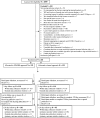Clinical effectiveness of a modified muscle sparing posterior technique compared with a standard lateral approach in hip hemiarthroplasty for displaced intracapsular fractures (HemiSPAIRE): a multicenter, parallel-group, randomized controlled trial
- PMID: 38895600
- PMCID: PMC11184196
- DOI: 10.1136/bmjsit-2023-000251
Clinical effectiveness of a modified muscle sparing posterior technique compared with a standard lateral approach in hip hemiarthroplasty for displaced intracapsular fractures (HemiSPAIRE): a multicenter, parallel-group, randomized controlled trial
Abstract
Objectives: Assess the effect of a modified muscle sparing posterior approach; SPAIRE (Save Piriformis and Internus, Repairing Externus), in hip hemiarthroplasty for displaced intracapsular fractures on postoperative mobility and function compared with a standard lateral approach.
Design: Pragmatic, superiority, multicenter, parallel-group, randomized controlled trial (with internal pilot). Participants, ward staff, and research staff conducting postoperative assessments were blinded to allocation. A CTU allocated treatments centrally using computer-generated lists.
Setting: Six hospitals in Southwest England, recruiting November 25, 2019-April 25, 2022.
Participants: 244 adults (≥60 years) requiring hip hemiarthroplasty (122 allocated to each approach). 90 and 85 participants allocated to SPAIRE and lateral, respectively, had primary outcome data within the prespecified data collection window.
Interventions: Surgery using SPAIRE or standard lateral approach. Follow-up 3 days and 120 days postoperation.
Main outcome measure: Oxford Hip Score (OHS), via telephone at 120 days. Secondary outcomes: function and mobility (3 days), pain (3 days, 120 days), discharge destination, length of hospital stay, complications and mortality (within 120 days), quality of life and place of residence (120 days).
Results: Participants' mean age was 84.6 years (SD 7.2); 168 (69%) were women. Primary outcome: little evidence of a difference in OHS at 120 days; adjusted mean difference (SPAIRE-lateral) -1.23 (95% CI -3.96 to 1.49, p=0.37). Secondary outcomes: indication of lower participant-reported pain at 3 days in SPAIRE arm; no differences between arms for remaining outcomes.
Conclusions: Participants' mobility and function are similar in the short term (3 days) and longer term (120 days), whether receiving the SPAIRE or lateral approach. Neither approach confers benefit over the other in terms of length of hospital stay, return to prefracture residence, survival within 120 days, or quality of life at 120 days. Participants receiving SPAIRE approach may experience less pain in the early postoperative period. Modifying the posterior approach in hip hemiarthroplasty to the SPAIRE approach gives equivalent patient outcomes to the lateral approach within 120 days.
Trial registration number: NCT04095611.
Keywords: Orthopedic Devices; Patient Outcome Assessment.
© Author(s) (or their employer(s)) 2024. Re-use permitted under CC BY. Published by BMJ.
Conflict of interest statement
Competing interests: All authors have completed the ICMJE uniform disclosure form at http://www.icmje.org/disclosure-of-interest/ and declare funding from the National Institute for Health and Care Research (NIHR) Research for Patient Benefit programme (PB-PG-0817-20039) for the submitted work; financial relationship between author AJT and Stryker in the previous 3 years; no other relationships or activities that could appear to have influenced the submitted work.
Figures
References
-
- Royal College of Physicians . National hip fracture database annual report 2017. London, 2016. Available: https://www.nhfd.co.uk/2017report
-
- Royal College of Physicians . National hip fracture database annual report 2016. London, 2016. Available: https://www.rcplondon.ac.uk/projects/outputs/national-hip-fracture-datab...
-
- Hip fracture: the management of hip fracture in adults (CG124). 2011. Available: https://www.nice.org.uk/guidance/cg124
-
- Kristensen TB, Vinje T, Havelin LI, et al. . Posterior approach compared to direct lateral approach resulted in better patient-reported outcome after hemiarthroplasty for femoral neck fracture: 20,908 patients from the Norwegian hip fracture register. Acta Orthop 2017;88:29–34. 10.1080/17453674.2016.1250480 - DOI - PMC - PubMed
Associated data
LinkOut - more resources
Full Text Sources
Medical
Miscellaneous

